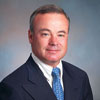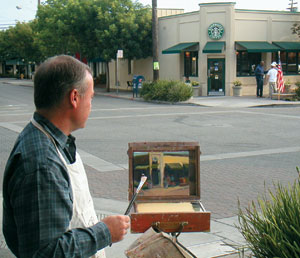Fred Gibbons
By Karen Thomas (BA '75)
 Striding through an alley one day on
his way to work, Fred Gibbons (BSE Science
Eng '72; MSE CICE '72) stopped in his tracks, attracted by a
trio of trash cans and the pattern of shadows they cast
behind a Palo Alto restaurant. Taking a short break from his
hectic schedule as founder and CEO of Venture-Concept, a
high-tech venture capital firm, Gibbons returned the
next day, paints and brushes in hand. In less than an
hour (his time limit for all his oil paintings), he captured
the cans on canvas. The completed gallery-quality work joined
34 others on Gibbons' Web site
(www.venture-concept.com/cv/resume.htm), which also contains
a number of more conventional items, such as his resume and
descriptions of companies he's helped start. Striding through an alley one day on
his way to work, Fred Gibbons (BSE Science
Eng '72; MSE CICE '72) stopped in his tracks, attracted by a
trio of trash cans and the pattern of shadows they cast
behind a Palo Alto restaurant. Taking a short break from his
hectic schedule as founder and CEO of Venture-Concept, a
high-tech venture capital firm, Gibbons returned the
next day, paints and brushes in hand. In less than an
hour (his time limit for all his oil paintings), he captured
the cans on canvas. The completed gallery-quality work joined
34 others on Gibbons' Web site
(www.venture-concept.com/cv/resume.htm), which also contains
a number of more conventional items, such as his resume and
descriptions of companies he's helped start.
Whether he's painting "Boats at Monganui Harbor, New
Zealand," "Umbrellas at Auberge du Soile," an abandoned
tractor in Los Altos or an Atlas preserves jar in a garage,
Gibbons stresses that most of his subjects have an
engineering orientation. "I paint things," he said, "found
objects I discover as I'm walking around. I'm a street
painter; you'll never find me in a studio." (He also paints
people he finds interesting, including three homeless
fishermen he paid $20 apiece to linger a bit longer on
a San Francisco pier.)
"The process of building a company is almost identical to
the way I paint," Gibbons observed. "First, it's a creative
problem. When you start a company, it's a blank canvas where
a business plan will eventually show up. I also look for that
'Aha!' moment, an immediate reaction to the concept behind
the company."
Gibbons reacted that way when several former students (he
teaches a business management course for engineers at
Stanford) approached him in 2000 with an odd-looking
contraption: a digital camera Velcroed to a cell phone.
Hijacking the camera's operating system to install a new
application, they'd created an elegant, ingenious
product.

CEO/artist Fred
Gibbons captures the kingdom of cafe mochas on
canvas. |
"I get it," Gibbons said. "This will help insurance agents
take on-scene damage photos." Instead of a cumbersome
paper-filing system, one push of a button sent the pictures
into easily retrievable Web storage.
Today, ActivePhoto, joined by Sprint and serving half a
dozen major insurance companies with 40,000 photos a month,
is close to breaking even on annual revenues of $1 million
(double last year's tally).
Gibbons started his first company, Software Publishing
Corporation, in 1981, based on a similar blend of quick-take
assessment and gut-level premonitions. While working at
Hewlett-Packard, marketing its 3000 mini-computer line, he
"got a call from some kid who said, 'I'm starting this
computer company. Want to join?'"
The "kid" was Steve Jobs, who showed Gibbons an Apple I
computer, asking if he'd like to do the market-requirement
planning.
However, plastic bags lying nearby distracted Gibbons.
What was in them? "Oh, that's software," Jobs replied, adding
an explanation necessary at the time: "It's stuff people
write and sell like sheet music."
"And," Gibbons recalled, "just like walking down that
alley and noticing how light played across trash cans, I
recognized opportunity." Jobs offered him a position, HP
tried to keep him, but Gibbons used his Visa card and $50,000
from a second mortgage to start his company. His products
were classic productivity software: word processing,
spreadsheets and graphics designed for first-time
users.
"My instinct, if you want to call it that," Gibbons said,
"was that everybody who was going to use these things had
never used a computer before, so they'd better be dumb,
simple, easy." Nimbly changing his focus from retail mass
distribution as Microsoft emerged, Gibbons invented a new
category (presentation graphics) and a hugely successful
product, Harvard Graphics.
Starting with one employee-himself-and zero revenues,
Gibbons achieved $50 million in revenue by 1985, and $150
million in 1990. The company had 1,000 staffers by the time
he sold it in 1994.
Raised in Woods Hole, Massachusetts, Gibbons, 52, was an
entrepreneur almost by the time he could add. At age 7 he
picked blueberries for 35 cents a quart, caught and sold
lobsters when he was 12, and later took people on boat trips
at 25 cents a head. He credits the College for giving a
passionate direction to his drive, exposing him to computers
in 1967, when they were unknown or a novelty in most
classrooms. Fascinated that he could create mechanical
drawings on a Calcomp plotter, Gibbons remains grateful that
the College allowed him to create both bachelor's and
master's degrees around computer science, when it didn't even
offer a formal computer major.
"The school was at the forefront of technology that turned
out to be very important to me personally, and I got early
exposure to it from a couple of great guys - professors Frank
Westervelt and Bernard Galler," he said.
In 1995, Gibbons (who also holds a Harvard MBA) became a
teacher himself, putting together, in one course, a condensed
first-year MBA program (20 high-tech case studies) for
Stanford's Graduate School of Engineering. "Out of 350
students I've taught, at least two dozen have gone on to get
MBAs," he noted with satisfaction. "Another dozen or
so have started companies." They include Larry Page
(BSE CE '95), who created Google, as well as founders
of FogDog, an online sporting goods vendor, and Reflectivity,
which focused on optical switching (the latter two are among
Venture-Concept's successful startups).
Gibbons also told the story about two Stanford PhD
candidates who heard about his course and approached him
about their startup. "These kids with their golf clubs and
pizza boxes everywhere had this thing that found stuff on the
Web," he recalled. Gibbons helped persuade a venture capital
firm to invest $1 million in Yahoo, wrote a personal check
for $50,000, and "the rest is history," he said.
For the foreseeable future, Gibbons plans to balance his
life between the two compatible poles of teaching and doing.
"I don't raise venture capital in the traditional sense," he
said. "I don't put large sums of money into companies I work
with; it's typically a half million to a million dollars. I
look for small ideas that could be big. But even Yahoo
was more hope than certainty.
"I suspect I'll be doing bigger things in the future," he
added, "only because in this post-bubble environment, my
approach seems more and more relevant."
Gibbons' advice to would-be entrepreneurs is the same for
neophyte artists: "Don't be afraid to try." And while he
doesn't actively attempt to sell his paintings, people often
make on-the-spot offers while he's still layering final
flecks of color. Unfinished, unframed, still wet, some have
gone for as much as $600. Not bad for an hour's work.
(Gibbons donates proceeds to a local arts center.)
Like his investors, appreciative strangers see value
in what Fred Gibbons creates.
For significant contributions to academia and business,
Gibbons received the 2000 EECS Alumni Society Merit Award
from the College. -E
Karen Thomas is a freelance writer whose work has
appeared in McCall's, Family Circle, American Profile
and other national publications.
- Michigan Engineer Fall/Winter 2002
(College of Engineering) |